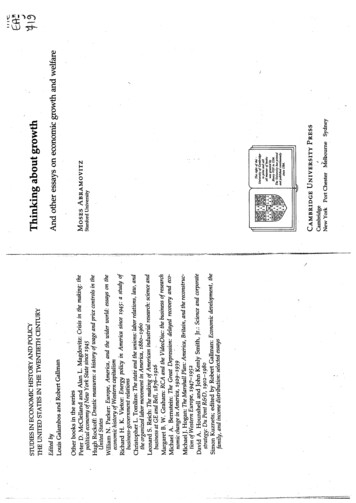
Transcription
family,and income distribution: selected essaysSimon Kuznets; edited by Robert Gallan: Economic development, thestrategy: Du Pont R&D, 1902-1980David A. Hounshell and John Kenly Smith, Jr.: Science and corporatenomic change in America, 1929-1939 .Michael J. Hogan: The Marshall Plan: America, Britain, and the reconstruction of Western Europe, 1947-1952Michael A. l3emstein: The Great Depression: delayed recover and eco-the organized labor movement in America, 1880-1960Leonard S, Reich: The making of American industrial research: science andbusiness at GE and Bell, 1876-1926Margaret 13, W, Graham: RCA and the VideoDisc: the business of researchChristopher L. Tomls: The state and the unions: labor relations, law, andbusiness-government relations .Richard H. K. Vietor: Energy policy in America since 1945: a study ofeconomic history of Western capitalismWilliam N. Parker: Europe, America, and the wider world: essays on theHugh Rockoff: Drastic measures: a history of wage and price controls in theUnited Statespolitical economy of New York State since 1945Other books in the seriesPeter D, McClelland and Alan L. Magdovitz: Crisis in the making: theLouis Galambos and Robert GallmanEdited bySTUIES IN ECONOMIC HISTORY AND POLICYTHE UNITED STATES IN THE TWNTIETH CENTURY"ì'iil;IiThe Universi'y has printedand published coniinuolUlYsince 1 84.Henry VI/I in /534.The right of ihë "Univ f3ity a/Cambridge'10 print and sellall manner of booksWQS granted byNew York Port Chester Melbourne SydneyCambridgeCAMBRIDGE UNIVERSITY PRESSStanford UniversityMOSES ABRAMOVITZAnd other essays on economic growth and welfareThinking about growth\lt EA- .), i i-c
Published by the Press Syndicate of the University of CambridgeISBN 0 521 33396 2339.50\0\b 2R.UJJlnburg .Â. . . :lBibl§otrH, i- l O\Æll. S \ \Abramovitz, MosesThinking about growth: and otheressays on economic growth andwelfare. - (Studies in economichistory and policy; the United Statesin the twentieth century).1. Economic growthi. Title II. SeriesBritish Library Cataloguing in Publication DatàHC106,A33 1989 338.973 88-1890211, Series,welfare -United States - History. i. Title.1. United States-Economic conditions, 2. Public(Studies in economic history and policy)Abramovitz, Moses.Thinking about growth and other essays on economic growth and welfare.Library of Congress Cataloging-in-Publication DataPrinted in the United States of AmericaFirst published 1989I! Cambridge University Press 198910 Stamford Road, Oakleigh, Melbourne 3166, Australia32 East 57th Street, New York, NY 10022, USAThe Pitt Building, Trumpington Street, Cambridge CB2 1RPü:,I,.\1:LI;¡-To Carre, with love
i1'3crtical readig.ard Nelson, Nathan Rosenberg, Walt Rostow and the editors of this volume, LouisGalambos and Robert Galln. I owe a special debt to Paul David's thorough andread early drafts of this paper. They include Eli Ginzberg, Charles Kidleberger, Rich-I ackowledge with thanks the caeful review and encouragement of colleagues whosketch. It is spare and unshaded, as a sketch must be. It deals mainywith the causes of economic growth, not its consequences. It looks atgrowth, although it stretches over many pages, is sti no more than aThis sketch of the erratic involvement of economists with economicstands. both to the complexity of the subject and to the litations of economics and of the other social sciences as well. Yet the study of growth isgoing on energetically. It is interestig, therefore, to ask what thenewer work has added to the older and where the subject nowthe new research, however, have been modest, which is testíonya more sophisticated theoretical framework. The accomplishments ofof far better and more extensive historical and statistical materials andIn the new effort, much that had been known a century and moreago had to be relearned. The new effort has had the benefit, however,been proceeding with vigor for the last four decades.tive neglect, there was a resurgence of interest and study that hasafer the Second World War, following a hundred years of compara-tastes nor the scientific bent of the disciplie's exponents, And then,sion with the demise of capitalsm appealed to neither the politicalmists. It was left to Marx and his followers, whose premature obses-on the attention and imagiation of the great body of academic econo-century. As the Victorian Age wore on, however, growth lost its holdfiled the thoughts of economists for the next' three quarters of athe youngest. It was a pricipal concern of the Wealth of Nations, and itEconomic growth is one of the oldest subjects in economics and one ofThinkig about growthi
L! IC,Thinking about growth5liits of a stationary supply of land. Hegap between its population and the maxium number its land couldsupport. Growth tended to be rapid, therefore, when an increasingpopulation and a growig aggregate income were expanding marketsand opening the way to a sti more intense division of labor,thought a nation best off and most progressive when there was sti ato press on the physicallively sense of the tendency of people to multiply their numbers andof their talents and natural resources.With few exceptions, Smith thought, the "policy of Europe" shouldbe one of laissez-faire. But the Wealth of Nations also displays Smith'stools, and the accumulation of capital, finally feeding back to marketscale. Smith saw the political institutions under which peopl lived asthe main determnant to their abilty to exploit the scale advantagesmade possible by trade and, therefore, to their abilty to make full useof labor, thence to the enhancement of skis, the invention of newtheir savings, In Smith's view, therefore, the advance in productivitywas an interactive process that ran from scale of market to the divisionafforded businessmen a profitable and productive way to employthe profit rate downward. And since land, which is by definition infixed supply, is a third element, the increase of both capital and labormust decline and eventually come to a halt, even if they themselvesproportionately with population. But capital, since it is also an element in production, imposes a limit, unless it grows at the same rateas labor; but capital cannot long increase faster without swifty drivingHe feared the force of people's power of natural increase.Capital too tends to increase under the impulse of its earning power,As with the earnngs of labor, however, the profit rate must e'tceed amiimum standard, This threshold level is low where wealth is abundant and people's "effective desire for accumulation" is strong. It ishigh where business is risky and property insecure.If labor were the only element in production, output would increasetres had been declining; yet he did not fully trust such hopeful signs,Mill noted that population growth rates in these progressive coun-advanced countres of Western Europe" (p. 161).succeeding generation of the benefit" (p. 161). But Mill is a reluctantand somewhat qualied Malthusian. Conceivably people can come toraise their minium standard. "Every advance they make in education, civilization and social improvement, tends to raise this standardand there is no doubt that it is gradually, though slowly, rising in theand enabled clever artsans to devise labor-savig tools and devices; itenlarged the outlet for capital to embody the improved methods, andit out in the form which, by augmenting the population, deprives thetrades and tasks that raised the skis of workers, saved their time,to make of any advantageous change in their circumstances, is to, takestraint, population multiplies rapidly so long as output per head exceeds some minimum standard. "The use (people) commonly chooseWhat are these laws? On labor, Mi is a Malthusian, Free of re-ples, Ashley edition, p. 156) ,and Land, The increase of próduction, therefore, depends on the propertiesof these elements, It is a resùlt,of the increase either of the elements themselves, or of their productiveness, The law of the increase of production mustbe a consequence of the laws of these elements; the limits to the increase ofproduction must be the liits, whatever they are, set by these laws. (Princi-We may say, then, . . . that the requisites of production are Labour, Capital,The organiing theme of Mi's treatise has a distictly modem ring:possibilties of progress based on the advance of knowledge. JohnStuart Mi's Principles of Political Economy (1848) gave the economics ofgrowth its definitive statement at the hands of the classical economists,Smith's theories were developed and refined in the decades after theappearance of his great book. Malthus's famous essay on population,taken together with Ricardo's treatment of diminishing returns in theuse of land, sharpened the sense of conflct between population andresources. At thf' sáme tie, there was a growig appreciation of theThinking about growthlarge-scale activity permtted a specialization and simplication ofdevoted to the advantages of the division of labor and its dependenceon the scale of activity and the extent of the market. Smith saw thatto forge ahead and others to fal behind, His very first chapters arein its very title announces Smith's concern with the forces that governthe relative levels of prosperity among countres and that cause somepartcularly of the political economy of growth. The Wealth of NationsAdam Smith was the father, not oiùy of modern economics, but morei. Growth and the older economistsgrowth. In all these ways, this sketch of the terrain is incomplete;even so, it serves a purpose, particularly if more complete and detailed maps are not at hand.tr's capacity to accomplish such change lits its rate of aggregateglects the strctural change that growth requires, except as a coun-past work largely in terms of what it has contrbuted to our presentunderstanding. It deals with growth only as this presents itself inadvanced capitalist countres. It concentrates on the increase of productivity, the principal component of per capita output growth; and itsets aside the companion subject of population growth. It is concerned mainly with the overal productivity growth of nations; it ne-4
Mill's shift of emphasis reflects the seventy-five years that hadpassed between Smith, who wrote only on the eve of the IndustralRevolution, and the mid-nineteenth century, when powered machi-than population. (p. 191)ally to the labour employed, is increasing or dimnishig, . . depends uponwhether population is advancig faster than improvement, or improvementWhether, at the present or any other tie, the produce of industr proportion-race:viewed the economies of scale as affording only transitory relief untipopulation becomes dense enough "to allow the pnncipal benefits ofcombination of labor" (pp. 191-92). Thereafter, progress becomes awould say. Mi's discussion reduces the emphasis that Smith hadplaced on an extension of the market and division of labor. Mithe goal itself fles before us" (p. 746),The force that, in the last analysis, keeps the stationary state at bayis "improvement in the productive arts" -: technological progress, weverge of it, and. , , if we have not reached it long ago, it is becauseintellectual and moral development of people (Book iv, Ch. Vi).Whether the stationary state that looms before nations is one ofcomfort or misery, however, loom it does: ". . . we are always on thestate, which then would hold out very favorable prospects for thehowever, might maintain a comfortable conqition even in a stationarcould be brought to a halt before incomes fell to the bare mimumrequired to support life. It might remain much higher if people cameto insist on a higher standard of livig. Mill argued that restraints onbirths were necessary even in progressive countres to prevent population from outstrpping the increase of capitaL. The same restraints,the "progress of society must 'end in shalows and in misenes' " (p.747)' Malthus himself had recognized that the increase of populationUnlike his great predecessors, however, Mil did not believe thatapproach to it, (p. 746)wealth is but a postponement of this, and that each step in advance is anthey term the progressive state lies the stationary state, that all progress inmists, that the increase of wealth is not boundless: that at the end of whatIt must always have been seen, more or less distictly by political econo-inherent tendency for growth to cease: ',¡l¡:'r. -I¡tfwith the nse in the pnce of food, reduces the real income of workers,The rate of population growth is also reduced. There is, therefore, annot because, "in the particular circumstances of a given age orMore generally, the provision of such faciities, important to thepublic interest, that private individuals might provide, but wilagency" - for example, by joint stock companies - and the regulation or public provision of servces that are natural and practicalmonopolies- gas and water companies, railroads, canals.The regulation of activities that can only be done by "delegatedThe protection of those kinds' of goods that belong to people incommon but are used by all individually - the environment.The provision of goods or the support of servces whose social utiityexceeds their private - education and scientific research (besideslighthouses and buoys).able public activity or intervention stand out:subject at length; but in an essay on growth, four instances of desir-limits of the pnnciple of laissez-faire.As to the last, Mill felt tom. He maintained the common convictionof political economists from Hume and Smith forward that individuals should enjoy the greatest possible scope to engage in trade and tocontract freely with one another. Yet he insisted that this pnnciplewas itself limited in extent and admitted of exceptions. He treated thesome, and distortonal as possible - and finally, the proper extent andlarly concerned with four matters: the secunty of property as a condition of saving and investment; the capacity of people for effectivecooperation as a basis for the conduct of industr on a large scale; theproper pnnciples of taxation - to make taxes as little arbitrary, burden-rangements and public policies of national economies. He was particu-Mil, like his predecessors, laid great stress on the institutional ar-new industrial inventions, or an extended use of those already known, butimprovements in institutions, education, opinions and human'affairs generally, provided they tend, as almost all improvements do, to give new motivesor new facilties to production. (p. 192)Improvement must be understood . . . in a wide sense, including not onlyMi's view of the matter is ample and spacious, and it has taken latereconomists some time to regain his sweeping view, if, indeed, theyhave,nature. (p. 696)human föresight can extend, the urited, growth of man's power overconnexion with the phenomena of Production, is the perpetual, and so far asOf the features which characterie this progressive economical movement ofcivilzéd nations, that which first excites attention, through its intimateThe consequent decline in the rate of capital accumulation, togetheri7ery, the railroad, the steamship, and the electromagnetic telegraphThinking about growthhad begun to create a sense of the further possibilties of technologicalprogress.Thinking about growthincrease in step with one another, They meet dimnishing returns asthey are employed together with a fixed amount of land; the return tocapital is then dnven down as rents increase at the expense of profit.6
f .,.,the necessarythe means" (p. 978).resources, or too litte advanced in intellgence to apprecite theends, or not sufficiently practiced in joint action to be capable ofnation," the public is either "too poor to commandThinking about growthsical theory of relative prices and resource allocation, which came toseem such a solid constrction on its static foundations. The theorytreated a nation's institutions, its population, and its technology, thehaps economists were seduced by the logical coherence of the neoclas-question of income distrbution became more urgent issues. Or per-economic growth itself - made workig people a stronger politicalforce. Correspondingly, the claims of labor and, more generally, thespread education, and the extension of suffrage - all concomitants ofgrowth had become absorbed into a more general vision of humanprogress, it was nO longer seen as a problem. Or perhaps it wasdisplaced by other pressing concerns. Higher incomes, more wide-did not expand. Quite the contrary! Perhaps because economiclearned to smile; it absorbed the century's wider faith in unboundedProgress,Yet the place of growth in the studies and writigs of economistscal advance continued at a rapid pace. Even the dismal sciencelands and brought food and raw materials cheaply to more populouscountres, The population response became weaker while technologi-well as manufacturing. Applied to transportation, it openèd newcontinuity. The result was his vision of a race between population andimprovement whose winner was uncertain.This ambivalent atttude gradualy disappeared as the last centuryin the United States, and in a gradually wideningwore on. In Britain,sphere in Europe incomes rose from decade to decade, Power andmachinery applied to industr increased productivity in agrculture asvance of the industral arts, but he was unsure of their pace andOne of the strong impressions one takes from Mi is his ambivalenceabout the balance of growth forces. He sensed that population growthwas beginning to be limted, but he feared the strength of the humancapacity and drive to multiply, He perceived the possibilties of human kid's growing mastery over nature and of the cumulative ad-II. Growth and economics during the hiatusNo one can read, or reread, Mi without feeling how far he and theother classical economists had anticipated contemporary work, howmuch we may learn from them, and also. how much we had forgottenduring the century-long hiatus when growth studies were neglected.89knowledge, the actual introduc-.pecuiar function of entrepreneurs. His view implied that market com-Schumpeter argued that inovation was an economic activity, theolder economists had treated both as autonomous developments, buttion of new products or new methods in commercial operations. Thewhich was the exploitation of suchSchumpeter went further. He distiguished between "invention,"or the advance of knowledge useful in production, and "innovation,"accumulation and the return to capital On the rate of improvement.plus net profit) to a minimUI and the dependence of net capitalinforced the older views about the, tendency of gross profit '(nterestcontrbution to the economics of growth, they repeated and re-gial product of capital to zero. iSchumpeter's arguments were intended first of all to enlarge thefoundations of the neoclassical theory of factor prices. As a positiveaccumulation embodying an unchangig technology drove the mar-repetitive round, there would be nO function for entrepreneurs andnO occasion for profit, And interest would disappear as continuedProfit is, indeed, the reward for the successful introduction of newmethods and products. If' economic activity followed an unceasing, vance neither a positive interest rate nor net profit would persist.gued that in the absence of population growth and technological ad-tion, His early classic, The Theory of Economic Development (1911), ar-To all this Joseph Schumpeter was an honorable and notable excep-other than the conditions of general equilbrium. lations,and the Great Depression provided a quarter-century of distractions for those economists who were mided to 'study somethingthe industralworId after 1914, Two great wars, the postwar hyperin-borders of static theory was absorbed by the troubles that engulfedstatic theory. finally, whatever impulse there was to break out of theof markets, an element in economic growth as well as a problem foraccumulation, productivity growth, rising incomes, and the extensionthe equilbrium of relative prices, And Alyn Young had to wrte afamous essay (1928) to remid economists that it was somethigmore, part of an interactive and cumulative process involvig capitalbasic insight - came to be viewed as just a problem for the theory ofscale, the division of labor and increasing returns - Adam Smith'sOn economics, at least On the science that economists had the ambition to build. It left growth outside its borders, Even the subject ofmainl neglected. Neoclassical theory, therefore, imposed boundariesresource allocation adjusted. But the causes of their changes were notsubjects for, economists to investigate, and their implications werewere viewed as the cOnstraints and conditions to which prices andcentral elements of the growÜi process, as autonomous data. TheyThinking about growth
Thinking about growth11risks and costs of advanced capitalist life drove countres to developsystems of protection and benefit - the welfare state. It was quicklyappreciated that it would be easier to pay for these systems fromrising incomes than from redistrbutive taxes. The political tensionsand social conflict inherent in redistrbution would be mitigated bygrowth.and long-lived corporations had displaced the individual entrepre-porate versions of the same ideas; but that revival of Schumpeterianeconomics remained for the futue. While their attention was directedactivity. Economists' present models of technological progress incor-commercial exploitation had become "routine" aspects of businessneur, he suggested that both the search for new technology and itsthe democratic suffrage in the industralied countres, a strongeregalitarian sentiment, and people's heightened appreciation of theoutside the economic system, and innovation, which was regarded asOn another level, the rivalr betwèen the US?R and the UnitedStates made each countr anxious to prove that its system was capable ofp'aducing ever higher material conditions and was thereforeworthy of emulation, frendship, or even allance.Internal political forces also pressed for growth. The enlargement ofregies.Similarly, the newly independent countres, the former colonies,saw economic growth not only as the means of rising from povertybut as a necessary condition for consolidating their new politicalbusiness investment of a bold and risky sort. Recognizing that largeearly writings had drawn between invention, the product of activitiesSchumpeter now also abandoned the sharp distinction that hisnewed by the innovative activity of entrepreneurs.progressive economy - constantly lited, but also constantly re-Some degree of monopoly power,therefore, was a regular feature of aimitative inroads and further innovations of rival entrepreneurs.pries were transient, being diluted and eventually eliinated by thesary, therefore useful, inducements and rewards - an acceptableprice for the benefits of innovation and growth. Moreover, theseeral education, their experience with modern commerce, industr,and finance, and their political institutions should be able to support amuch higher relative status,even earlier. They correctly felt that their levels of scientific and gen-profits, He now argued that inovation rested not only on the lure ofhigh but competitive profits; often it also conferred monopoly powerand its concomitant monopoly profits, Al these he viewed as neces-their security and power as restig on an economic base. To ensuretheir independence and safety, they' concluded they must grow; ifahead, stay ahead; if behid catch up,Europeans became aware that they had lost ground to the UnitedStates in levels of livig not only durig the war but since 1913 andPeople, including politicians, realized that the outcome of the warhad been determined by GNP. More than ever before, nations viewedwere pressures for growth to achieve other urgent social objectives.There were considerations of national security and rivalry, of theconquest of poverty, and of advances toward prosperity, and therehowever, quickly shifted. Growth became a primary goal of nationalpolicy and consequently an absorbing subject of study by economists.That was how matters stood as World War II came to an end, Interest,III. The postwar revival of interest in growth and theresponse of economicsielsewhere, economists' views ,about economic growth remained unformed. Guided by neoclassical theory, they treated technological advance - as independent of economic incentives and saw only capitalaccumulation as a source of productivity growth responsive to economic causes,Thinking about growthracy (1942). Here he enlarged on his earlier ideas about the role ofcially by the theses of his later work, Capitalism, Socialism, and Democ-II, economists studied Schumpeter again. They were attacted espe-When interest in economic growth finaly revived after World Wardated within the domiant neoclassical modeL.suggest that the uncertainties accompanyig inflation and other financial disturbances could pose a lastig obstacle to innovation and productivity growth - a lesson for the contemporary scene and season.Schumpeter was widely admed for his briance and long neglectedfor his originality. His innovative theories were not easily accommo-growth and retardation and the financial distortions they brought intheir train, as part of the innovatory process, He was among the first tosaw business cycles, particularly the longer waves of acceleratedand their prices and costs without an undue sense of risk. Schumpetereconomic conditions so that businessmen could gauge their marketscessful innovation: open markets to permt. the appearance of "newmen" and "new firms," access to credit, and suffciently stable macro-economics of grQwth. As such, he stressed the requirements for suc-was thought to establish their equilbrium.Schumpeter taught that innovation was the central element in thepetition included rivalr in the intfoduction of new products andprocesses. Relative prices, therefore, were in flux, constantly disturbed by the same market competition that in the received theory10
The qualified tendency to convergence in the productivity growthrates and levels of industnalized counmes.pronounced acceleration following World War II and the retardation of the last 15 years,The gradual spread of modern growth from Bntain to the UnitedStates, Europe, the counmes of European settlement, and Japan.The secular acceleration of productivity growth; in particular thetion growth in the course of indusmalization.The demographic transitions from nsing to declining rates of popula-The nse of aggregate and per capita growth rates associated with theonset of "modem economic growth."which much analytical workis directed, A list of such generalizations,incomplete but ilustrative, includes the followig:stiulated and supported similar efforts in other countres. The empirical generalizations that he and his collaborators and followers established comprise many of the broad facts towards an explanation ofand other vital statistics, labor force, wealth, and many others. Heextended the U,S. national product series back to 1870. He encouragedthe compilation of long-term statistical data to supplement the nationalproduct figures and assembled many of them himself - populationtional product and national income accounts. He worked out theirconceptual bases, made the early estiates for the United States, andKuznets's great achievement was the foundation of the modem na-considerable number of countres, Simon Kuznets's work is the greatin some respects Colin Clark wasexemplar of such studies, althoughhis precursor.ment was to establish theobservable characteristics of growth on thebasis of a wide survey of experience over long periods and across aon private enterprise and market gudance.The growth studies fell Ilto two divisions. The first was principallyhistorical and descriptive. 'Its aim and, indeed, its solid accomplish-resources and a system of central plannig and control had beenestablished. This essay deals with the first of these, growth in thepresently industralized countres whose economies depend mainlytres, where a new set of institutions based on the state,ownership ofinstitutions and capabilties for exploitig contemporary technologyremained to be established. A third concerned the communist coun-ing from a preindustral condition, the countres in which the basiccapable of operatig at or near the frontiers of modem technology,Another was the study of development in poor countres sti emerg-Calculations that decomposed the growth of output into thecontributions of labor input and labor productivity had been madeThe discovery of the Residualof growth, as it had been for Mil himself to think that the "increase ofproduction. . . is a result of the increase of the (inputs) themselves,or of their productiveness," But how much was due to the increase ofeach of the inputs and how much to that of their productiveness? Thatwas an obvious first question. "Growth accounting" was the attemptto answer it,featue of their static models of price and income distrbution, It wastherefore as natural for economists, when they returned to the ¡,tudyorganizing theme of Mi's Principles. The same fundamental notionwas taken over by the neoclassical economists and became a centraloutlook of the classical economists, and, as we have seen, it was thepioneers in the measurement of national income and product and ofassociated data on labor force and capital stock were not aimess excursions into the statistical cosmos, They were guided by the conceptionof a production function, which is to say by the idea that output is afunction of the inputs of labor, accumulated capital, and land and ofthe productivity of these factor inputs. This idea had been part of theThe descriptive efforts of Colin Clark, Simon Kuznets, and the otheriV. The proximate sources of growthconcern of the rest of this paper.vations, they are the indispensable background for analytical w
i1' i Thinkig about growth Economic growth is one of the oldest subjects in economics and one of the youngest. It was a pricipal concern of the Wealth of Nations, and it filed the thoughts of economists for the next' three quarters of a century. As the Victorian Age wore on, however, growth lost its hold on the attention










